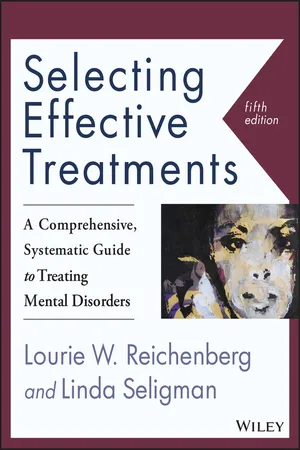
Selecting Effective Treatments
A Comprehensive, Systematic Guide to Treating Mental Disorders
- English
- ePUB (mobile friendly)
- Available on iOS & Android
Selecting Effective Treatments
A Comprehensive, Systematic Guide to Treating Mental Disorders
About this book
The bestselling treatment guide, updated to reflect changes to the DSM-5
Selecting Effective Treatments provides a comprehensive resource for clinicians seeking to understand the symptoms and dynamics of mental disorders, in order to provide a range of treatment options based on empirically effective approaches. This new fifth edition has been updated to align with the latest changes to the DSM-5, and covers the latest research to help you draw upon your own therapeutic preferences while constructing an evidence-based treatment plan. Organized for quick navigation, each disorder is detailed following the same format that covers a description, characteristics, assessment tools, effective treatment options, and prognosis, including the type of therapy that is likely to be most successful treating each specific disorder. Updated case studies, treatments, and references clarify the latest DSM-5 diagnostic criteria, and the concise, jargon-free style makes this resource valuable to practitioners, students, and lay people alike.
Planning treatment can be the most complicated part of a clinician's job. Mental disorders can be complex, and keeping up with the latest findings and treatment options can itself be a full time job. Selecting Effective Treatments helps simplify and organize the treatment planning process by putting critical information and useful planning strategies at your fingertips
- Get up to speed on the latest changes to the DSM-5
- Conduct evidence-based treatment suited to your therapeutic style
- Construct Client Maps to flesh out comprehensive treatment plans
- Utilize assessment methods that reflect the changes to the DSM-5 multiaxial system
Effective treatment begins with strategic planning, and it's important to match the intervention to your own strengths, preferences, and style as much as to the client's needs. Selecting Effective Treatments gives you the latest information and crucial background you need to provide the evidence-backed interventions your clients deserve.
Frequently asked questions
- Essential is ideal for learners and professionals who enjoy exploring a wide range of subjects. Access the Essential Library with 800,000+ trusted titles and best-sellers across business, personal growth, and the humanities. Includes unlimited reading time and Standard Read Aloud voice.
- Complete: Perfect for advanced learners and researchers needing full, unrestricted access. Unlock 1.4M+ books across hundreds of subjects, including academic and specialized titles. The Complete Plan also includes advanced features like Premium Read Aloud and Research Assistant.
Please note we cannot support devices running on iOS 13 and Android 7 or earlier. Learn more about using the app.
Information
Chapter 1
Introduction to Effective Treatment Planning
Why Is Diagnosis and Assessment Important?
Case Study 1.1
Case Study 1.2
Case Study 1.3
An Integrated Model for Treatment Planning
- Diagnosis
- Objectives of treatment
- Assessment—tools to help clarify assessment may include structured clinical interviews, inventories, scales, neurological tests, or may be as simple as symptom check lists and self-reports
- Clinician characteristics
- Location of treatment
- Interventions to be used
- Emphasis of treatment—for example level of support needed, level of directiveness by the therapist, whether focus is cognitive, behavioral, emotional, or a combination of the three
- Numbers—who should participate in treatment? Is the most effective treatment individual therapy? Family therapy? Group?
- Timing—frequency, pace, and duration of treatment
- Medications needed, if any
- Adjunct services—community services, support groups, alternative treatments
- Prognosis
Diagnosis
Table of contents
- Cover
- Title Page
- Copyright
- Table of Contents
- Dedication
- Preface
- Acknowledgments
- Chapter 1: Introduction to Effective Treatment Planning
- Chapter 2: Neurodevelopmental Disorders
- Chapter 3: Schizophrenia Spectrum and Other Psychotic Disorders
- Chapter 4: Bipolar and Related Disorders
- Chapter 5: Depressive Disorders
- Chapter 6: Anxiety Disorders
- Chapter 7: Obsessive-Compulsive and Related Disorders
- Chapter 8: Trauma- and Stressor-Related Disorders
- Chapter 9: Dissociative Disorders
- Chapter 10: Somatic Symptom and Related Disorders
- Chapter 11: Feeding and Eating Disorders
- Chapter 12: Elimination Disorders
- Chapter 13: Sleep-Wake Disorders
- Chapter 14: Sexual Dysfunctions
- Chapter 15: Gender Dysphoria
- Chapter 16: Disruptive, Impulse Control, and Conduct Disorders
- Chapter 17: Substance-Related and Addictive Disorders
- Chapter 18: Neurocognitive Disorders
- Chapter 19: Personality Disorders
- Chapter 20: Paraphilic Disorders
- Appendix: Suicide Assessment and Prevention
- About the Authors
- Author Index
- Subject Index
- End User License Agreement